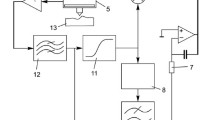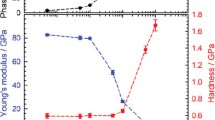Abstract
In this article, a new method based on the detection of the second harmonic of the displacement signal to determine mechanical properties of materials from dynamic nanoindentation testing, is presented. With this technique, the Young’s modulus and hardness of homogeneous materials can be obtained at small penetration depths from the measurement of the second harmonic amplitude. With this innovative method, the measurement of the normal displacement is indirectly used, avoiding the need for very precise contact detection. Moreover, the influence of the tip defect and thermal drift on the measurements are reduced. This method was used for dynamic nanoindentation tests performed on fused silica and on an amorphous polymer (PMMA) because these materials are supposed not to exhibit an indentation size effect at small penetration depths. The amplitude of the second harmonic of the displacement signal was correctly measured at small depths, allowing to calculate the Young’s modulus and the hardness of the tested materials. The mechanical properties calculated with this method are in good agreement with values obtained from classical nanoindentation tests.









Similar content being viewed by others
References
Tabor D (2000) The hardness of metals, Oxford University Press, s.d
Tabor D (1970) The hardness of solids. Rev Phys Technol 1(3):145–179
Bulychev SI, Alekhin VP, Shorshorov MK, Ternovskii AP, Shnyrev GD (1975) Determining Young modulus from the indenter penetration diagram. Ind Lab (USSR) (English Translation of Zavodskaya Laboratoriya) 41(9):1409–1412
Frohlich F, Grau P, Grellmann W (1977) Performance and analysis of recording microhardness tests. Phys Status Solidi A Appl Res 42(1):79–89
Newey D, Wilkins MA, Pollock HM (1982) An ultra-low-load penetration hardness tester. J Phys E Sci Instrum 15(1):119–122
Pethica JB, Hutchings R, Oliver WC (1983) Hardness measurement at penetration depths as small as 20-nm. Philos Mag A Phys Condens Matt Struct Defect 48(4):593–606
Doerner MF, Nix WD (1986) A method for interpreting the data from depth-sensing indentation instruments. J Mat Res 1(4):601–609
Oliver WC, Pharr GM (1992) An improved technique for determining hardness and elastic-modulus using load and displacement sensing indentation experiments. J Mater Res 7(6):1564–1583
Loubet JL, Bauer M, Tonck A, Bec S, Gauthier-Manuel B (1993) Nano-indentation with a surface force apparatus. NATO Advanced Study Institute Series E 429–447
Loubet JL, Georges JM, Meille G (1986) Vickers indentation curves of elastoplastic materials: Microindentation Techniques in Materials Science and Engineering. American Society for Testing and Materials, Philadelphia, Balu, PJ, Lawn BR, s. d. p. 72–89
Bertrand-Lambotte P, Loubet JL, Verpy C, Pavan S (2002) Understanding of automotive clearcoats scratch resistance. Thin Solid Films 420–421:281–286
Fischer-Cripps (2002) AC Nanoindentation, Springer-Verlag New York Inc., s.d
Asif SAS, Wahl KJ, Colton RJ (1999) Nanoindentation and contact stiffness measurement using force modulation with a capacitive load-displacement transducer. Rev Sci Instrum 70(5):2408–2413
King RB (1987) Elastic analysis of some punch problems for a layered medium. Int J Solids Struct 23(12):1657–1664
Alkorta J, Martínez-Esnaola JM, Sevillano JG (2005) Absence of one-to-one correspondence between elastoplastic properties and sharp-indentation load–penetration data. J Mater Res 20(2):432–437
Pharr GM, Oliver WC (2004) Measurement of hardness and elastic modulus by instrumented indentation: Advances in understanding and refinements to methodology. J Mater Res 19(1):3–20
Pharr GM (1998) Measurement of mechanical properties by ultra-low load indentation. Mater Sci Eng A 253(1–2):151–159
Hochstetter G, Jimenez A, Loubet JL (1999) Strain-rate effects on hardness of glassy polymers in the nanoscale range. Comparison between quasi-static and continuous stiffness measurements. J Macromol Sci B Phys 38(5):681
Bec S, Tonck A, Georges J-M, Georges E, Loubet J-L (1996) Improvements in the indentation method with a surface force apparatus. Philos Mag A 74(5):1061
Kermouche G, Loubet JL, Bergheau JM (2007) Cone indentation of time-dependent materials: the effects of the indentation strain rate. Mech Mater 39(1):24–38
Pharr GM, Strader JH, Oliver WC (2009) Critical issues in making small-depth mechanical property measurements by nanoindentation with continuous stiffness measurement. J Mater Res 24(3):653–666
Cheng Y-T, Cheng C-M (2004) Scaling, dimensional analysis, and indentation measurements. Mater Sci Eng R Rep 44(4–5):91–149
Hochstetter G, Jimenez A, Cano JP, Felder E (2003) An attempt to determine the true stress-strain curves of amorphous polymers by nanoindentation. Tribol Int 36(12):973–985
Sneddon IN (1965) The relation between load and penetration in the axisymmetric boussinesq problem for a punch of arbitrary profile. Internat J of Engrg Sci 3(1):47–57
Author information
Authors and Affiliations
Corresponding author
Appendix: Second Harmonic Detection with Displacement Controlled Systems
Appendix: Second Harmonic Detection with Displacement Controlled Systems
Continuous Stiffness Measurement Technique for Displacement Controlled Systems
The Continuous Stiffness Measurement method [8, 12, 13] consists in superimposing a harmonic displacement \( \tilde{z}(t) \), at given frequency (from 30 to 100 Hz), to the displacement:
where z 1 is the amplitude of the harmonic component and ω the circular frequency (rad/s). The load response is a series:
Where F i , φ i (i = 1…n) are respectively the amplitude and the phase of the harmonic components. The load response at the excitation frequency and the phase angle between load and displacement oscillation are measured continuously as a function of penetration depth. In order to determine the dynamic contact stiffness, the dynamic response of the system has to be determined. The frequency response function can be expressed by the following equation:
where m is the column mass, D = D i + D s is the global damping coefficient with D i the damping due to the air in the gaps of the capacitor plates displacement sensing system, D s the contact damping coefficient, \( K = {\left( {\frac{1}{{{K_f}}} + \frac{1}{S}} \right)^{{ - 1}}} + {K_s} \) is the total dynamic stiffness with K f the frame stiffness and K s the support springs stiffness. In addition, the load signal is a function of the displacement signal modulated by an oscillation, so the load signal at the vicinity of z can be expanded as a Taylor development (at the second order here):
Here, the Taylor development and the series (A2) are dependant of the harmonics terms of force and displacement. Considering equations (A2) and (A4), the harmonic terms of the series have to be equal term by term. For the first harmonic term, the following equality is obtained:
In this equation, the derivative of the force with respect to the displacement depends on the force and displacement amplitude, so according to equation (A3), the following equation is deduced:
So, the derivative of the load with respect to the displacement is equal to the frequency response function.
Second Harmonic Expression
Considering the second harmonic term, the following equation is obtained:
The above formula is interesting because the second harmonic of the load depends on the second derivative of the load with respect to the displacement. The second derivative can be computed by simply deriving equation (A6) with respect of z and by noticing that the only term which depends on the displacement variation is the dynamic contact stiffness.
Writing that: \( \tan ({\varphi_1}) = \frac{{D\omega }}{{K - {\omega^2}m}} \), assuming that the support spring stiffness K s is negligible compared to K , and using equations (A6) and (A7), the second derivative can be expressed by the following equation:
Equation (A7) can thus be rewritten in the following form:
By expressing the signal amplitude of load, the following equation is obtained:
The dynamic stiffness K and the dynamic contact stiffness S are the most important parameters in the above equation, because all the other terms are constant. It was plotted theoretically by the ratio \( \frac{{{K^2}}}{{{S^2}}} \) versus dynamic stiffness K (not shown). The dynamic contact stiffness S is calculated by the following equation:
with K f being the frame stiffness. Let be K f = 500,000 N/m. This is the frame stiffness of the SA2®. The ratio \( \frac{{{K^2}}}{{{S^2}}} \) decreases linearly when the harmonic stiffness increases. So, it is supposed that the load second harmonic amplitude decreases linearly during the indentation test. The expressions of the reduced contact modulus and the hardness can be obtained from equations (1) and (A11):
In these equations, the dynamic stiffness K, the applied load F and the phase angle φ 1 are measured by a classical nanoindentation technique using the CSM method, the circular frequency ω and the harmonic displacement amplitude z 1. They are set before the test, the dynamic contact stiffness S and the derivative of the contact radius being set with respect to the tip displacement γ are then calculated, β being a constant given by literature. At last, the second harmonic amplitude of load F 2 is measured with a lock-in amplifier. So, it is possible to determine the elastic modulus and the hardness of materials with second harmonic detection for displacement-controlled systems. Like load-controlled systems, as it can be observed in the above formulas, the displacement signal is not a parameter used in the equation. The displacement is only used to calculate γ, but this term, expressed in equation (20), is an easy-to-calculate constant (see paragraph V). Since it does not depend on displacement, but depends on displacement variation, it is thus not necessary to detect the contact very precisely. In addition, because the displacement measurement is not directly used, it is not needed to estimate the equivalent height of the tip defect.
Rights and permissions
About this article
Cite this article
Guillonneau, G., Kermouche, G., Bec, S. et al. Extraction of Mechanical Properties with Second Harmonic Detection for Dynamic Nanoindentation Testing. Exp Mech 52, 933–944 (2012). https://doi.org/10.1007/s11340-011-9561-5
Received:
Accepted:
Published:
Issue Date:
DOI: https://doi.org/10.1007/s11340-011-9561-5




